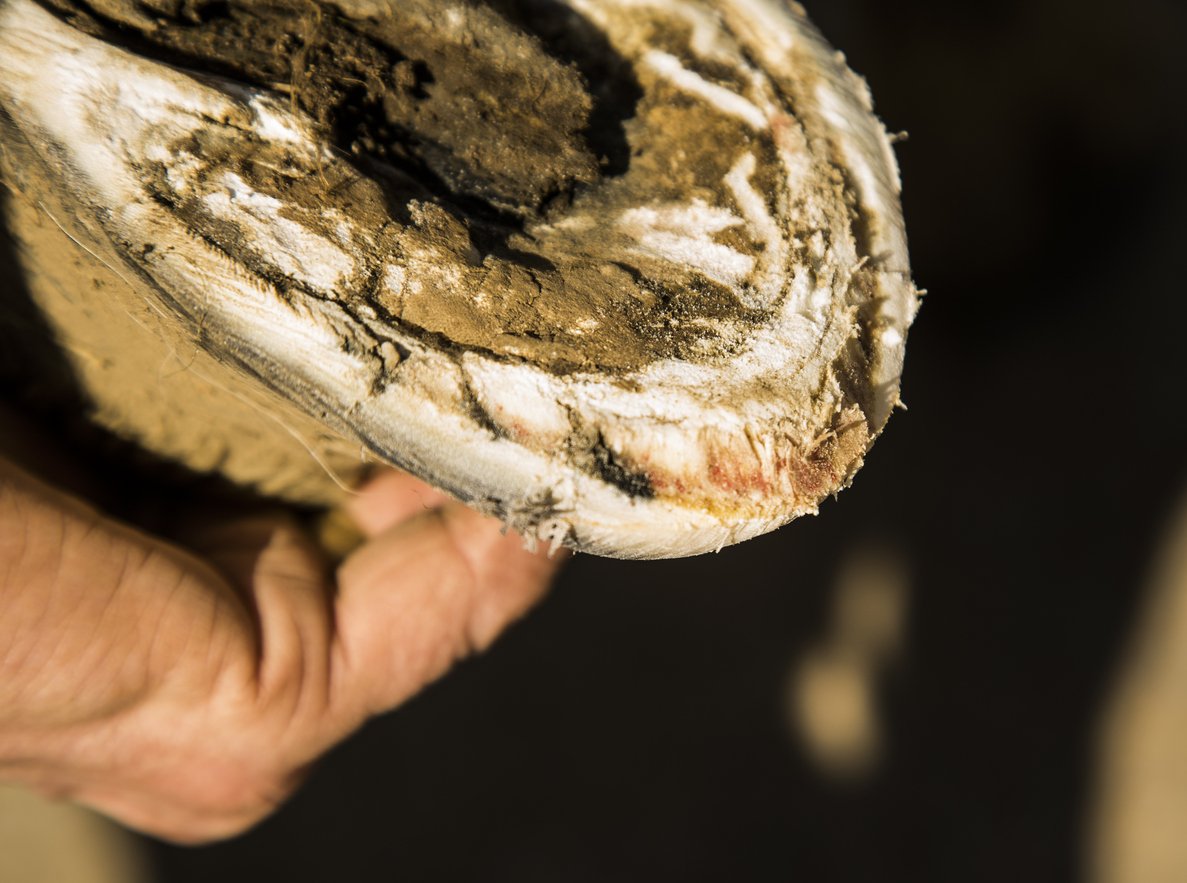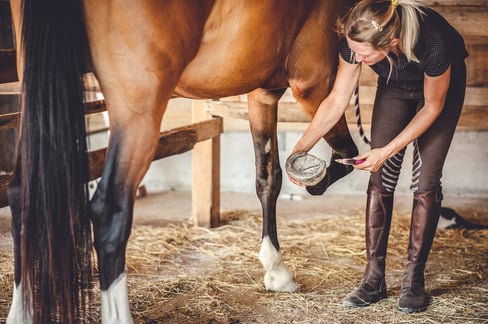Table of Contents
Horses have been a much-loved companion of humans for centuries, helping us perform a wide variety of everyday tasks easier and faster. Horses have been used to carry people and supplies to far-off lands, aid us in hunting, and even ridden to war.
Nowadays, horses are still used for riding and transportation, but the main reason why most people (at least in the western world) have horses is for pleasure; horse riding, competitions, and horse-related sports like showing and racing have dominated the average horse’s lifestyle.
Horses are our friends, and if you own a horse, you have a responsibility to care for him and provide the right combination of food, shelter, and exercise to keep your horse healthy and happy.
Unfortunately, like all animals, there are risks to a horse’s health that can occur if they are not taken care of properly. Laminitis is one of those horse diseases that can cause lifelong issues for your horse, and it’s a rather common disease.
According to recent research, the risk of your horse getting laminitis is about 15% — that’s a pretty stark statistic for the average horse. Let’s explore more about laminitis in horses and how you can recognize the early signs of this painful disease, as well as how you can work to prevent it from happening altogether.
Introduction to Laminitis in Horses
Laminitis in horses is a very serious disease that can cause extreme pain and even cripple the horse if left untreated. It’s also a common reason to explain a lame horse, especially in severe cases where the disease has progressed to a point of no return.
Horses are almost always standing, and therefore putting the majority of their weight on their feet (hooves). The most weight is placed on the horse’s coffin bone, which is located in the hoof capsule and is covered in a soft tissue called the corium. The corium can be compared to a human’s hyponychium or the “quick” of your fingernail. Imagine anything touching that sensitive part of your nail — ouch!
In horses, the corium is what provides nutrition, or blood flow, to the hoof. A normal hoof grows from the coronet band (seen in the diagram below) and straight down over the coffin bone’s wall. The coffin bone is anchored to the hoof wall by two layers of the lamina (laminae is the plural form) often called the white line, which is what you can see in the diagram. This, in combination with other structures of the horse’s overall foot, supports the horse’s weight and allows them to stand, gallop, and do everything a horse normally does comfortably.
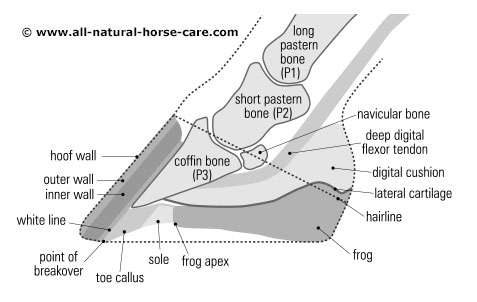
When laminitis in horses occurs, then that sensitive laminae become inflamed, causing the horse to experience pain in his hooves.
What is Laminitis in Horses?
The laminae of a horse’s hoof are actually two layers: the first layer is called the “sensitive lamina” and is what is attached to the coffin bone. The second layer is called the “insensitive lamina” and is attached to the hoof wall. The two layers are interlocked together with finger-like projections, which is what keeps them in place.
Laminitis occurs when one or both of the laminae become inflamed. Since the majority of a horse’s weight is put on its front limbs, laminitis commonly affects the front hooves. In severe cases, one or more of the layers of laminae can separate from where its attached, causing the coffin bone to sink or rotate downwards.
Below is a diagram comparing a healthy horse hoof to one that’s afflicted with laminitis.
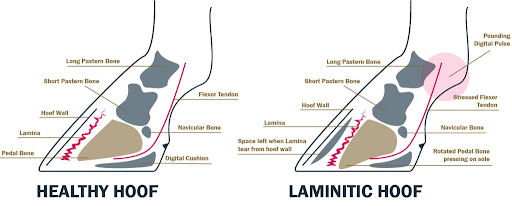
What Causes Laminitis in Horses?
Though research is ongoing, it is believed that the biggest causes of laminitis in horses are Equine Metabolic Syndrome (EMS) and Cushing’s disease. Poor nutrition, including dehydration, is another reason why laminitis in horses occurs.
The different causes of laminitis in horses are identified in the following table:
| Causes of Laminitis in Horses | How to Identify |
| Nutrition-induced laminitis | Caused by fermentation of a large number of carbohydrates in the hindgut (fructans from grass or starch from grains) from excessive consumption |
| Infection or sickness | Laminitis can occur as a secondary result of infection or sickness, such as diarrhea, retained placenta, and certain respiratory infections. |
| Obesity | Obesity can cause a variety of conditions that can lead to laminitis in horses, such as equine metabolic syndrome (insulin resistance caused by being overweight) |
| Trauma | Repeated physical trauma to the hooves (from horses being “ridden too hard”, for instance) can aid in the development of laminitis in horses. |
| Equine Pituitary Pars Intermedia Dysfunction (Cushing’s disease) | Can lead to laminitis due to the hormonal imbalances associated with this disease |
| Steroids | Though there is no specific scientific evidence to support this, there have been instances where steroid injections have appeared to cause the onset of laminitis in horses |
Table sources: Pubmed, thehorse.com, aaep.org
To summarize, laminitis in horses can be caused by a variety of factors, including diet, as a secondary result of disease, obesity, trauma, and steroid medications. It can be difficult for a horse owner to pinpoint the exact cause, but your vet may be able to help you identify other issues with your horse and help you see the relationship between those issues and laminitis.
For instance, proper equine nutrition is an extremely important factor in a horse’s health, and often a key indicator as to their risk factor for developing laminitis.
One way you can determine if your horse has nutrition-induced laminitis is if you’ve been feeding your horse too many grains, grass, or other food that is high in carbohydrates and sugars. These foods ferment in your horse’s gut and can lead to conditions like insulin resistance. Additionally, a diet rich in carbs and sugars can also lead to obesity in your horse, which in turn can lead to laminitis, so it’s really a double-edged sword.
This doesn’t mean you should never ever feed your horse grains or grasses, as they too are important parts of your horse’s overall diet. Horses have to eat almost constantly, so it’s not unusual for them to be in a pasture grazing on grass.
The key is to ensure that they are getting other foods to balance their nutrition out, rather than only consuming foods that are rich in carbs and sugars.
Common Risk Factors for Laminitis in Horses
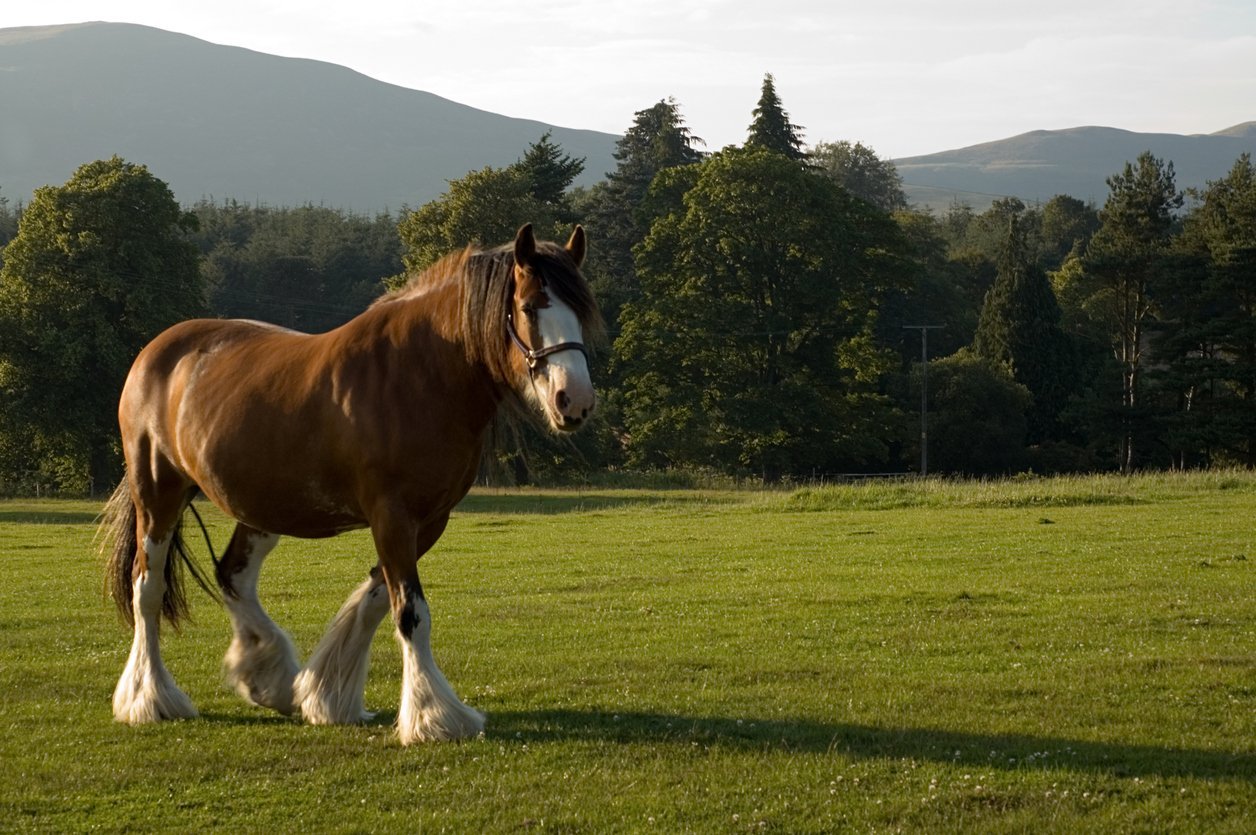
Common risk factors that seem to lead to the development of laminitis in horses include:
- Heavier breed horses, like draft horses, American quarter horse, Clydesdale, ponies, and more
- Horses that are overweight (any breed)
- Previous episodes of laminitis
- Older horses
- Horses with unlimited or unrestricted access to grain or other carbohydrate-rich foods
Signs of Laminitis in Horses
Perhaps you’ve noticed some changes in your horse’s behaviour, including some signs of lameness (frequent turning in circles, standing around and not moving much), a hesitant gait, or clear signs of pain in the hoof area. These are all signs that your horse could potentially be suffering from laminitis.
The clinical signs of laminitis in horses are:
- Lameness, which commonly affects two limbs or more (typically the front limbs)
- The horse leaning back onto his heels to reduce pressure on the toe area
- Lameness is more noticeable when the horse is walking on hard ground or turns
- Shifting weight when resting
- Increased digital pulses (easier to feel the horse’s pulse because tissue inflammation restricts blood flow to the hoof)
- Pain when hoof testers are used at the point of a frog on the hoof
These don’t cover all the possible symptoms of laminitis that a horse could exhibit, but they are the more common signs that your horse could be suffering from this disease.
Keep in mind that laminitis can be caused by respiratory diseases or even things that seem innocuous like diarrhea or weight gain, so it’s important to consistently monitor your horse’s overall health so you can easily identify warning signs that your horse could develop laminitis.
If you’ve analyzed these symptoms of laminitis in horses and suspect that your horse might be afflicted with this disease, it’s important to consult your vet so they can confirm whether your horse has laminitis or not, and help you begin a course of treatment for your horse if it turns out they do have the disease.
How to Prevent Laminitis in Horses
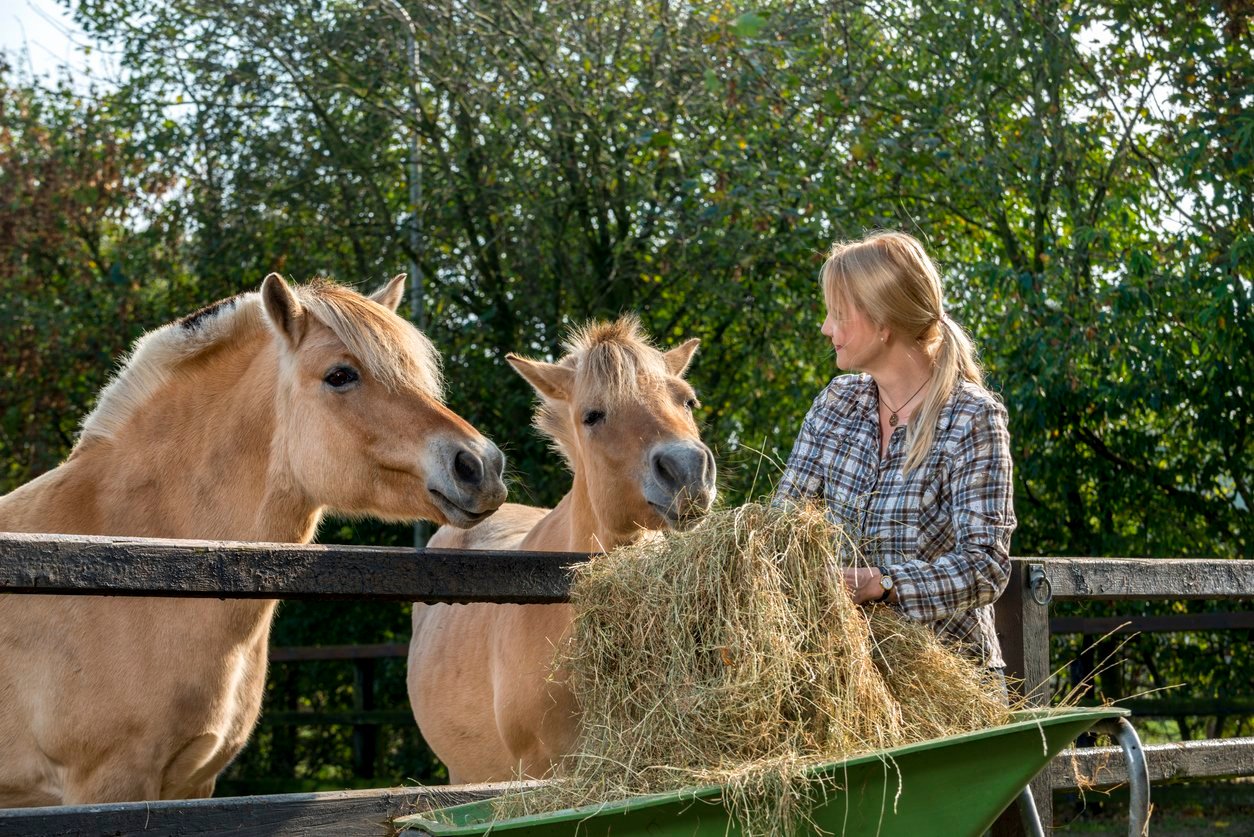
Prevention is key when it comes to avoiding diseases like laminitis in horses. The more measures that can be put in place to prevent your horse from developing this disease, the better health your horse will be in.
Common measures that work to prevent laminitis in horses are:
- Looking into laminitis supplements for horses, as these can provide the vitamins and minerals that your horse needs to maintain strong hooves.
- Minimize the amount of sugar and starches in your horse’s diet, as these compounds can lead to laminitis if the horse is fed consistently high amounts on a regular basis.
- Limit access to lush pasture, as the grass is high in sugar and carbohydrates, and consumption of a large amount of grass can lead to colic or laminitis.
- Manage your horse’s body weight, as extra weight can put unwanted pressure on your horse’s hooves, potentially causing damage to the laminae.
- Watch for signs of laminitis when treating your horse for other illnesses. Infections and other serious illnesses can lead to the development of laminitis, so it’s important to recognize the early signs and apply treatment as necessary.
Identifying the Types of Laminitis in Horses
Laminitis in horses can be broken down into two different types, acute laminitis and chronic laminitis.
| Type of laminitis | Description |
| Acute | Acute laminitis refers to the first onset of the disease in your horse, in that he has never suffered from laminitis before. |
| Chronic | Chronic laminitis means that your horse has experienced this disease before, and due to a variety of factors has developed laminitis again. |
Treatment options for both acute and chronic laminitis in horses are largely the same, but each horse should be individually assessed to determine the level the disease has affected the hooves. It’s extremely important that any potential dietary, metabolic, or environmental causes are determined as soon as possible so preventative measures can be put in place to ensure the disease doesn’t get worse.
Laminitis Supplements for Horses
Alongside closely watching your horse’s diet and ensuring you’re not overworking your horse or riding him too much on hard ground, providing supplements for your horse can also help prevent your horse from developing laminitis.
There are two equine-specific supplement products that we sell: TRI-ACTA for Equine and TRI-ACTA H.A. for Equine.
- TRI-ACTA for Equine is a regular strength supplement for younger horses that provides preventative care to maintain joint function and mobility as they age. It can also be used for older retired or pleasure horses as a way to promote long-term joint health and ease of movement.
- TRI-ACTA H.A. for Equine is a maximum strength formula that is built off of TRI-ACTA for Equine but adds the highly therapeutic benefits of an equine-specific hyaluronic acid. TRI-ACTA H.A. for Equine is recommended for horses that are experiencing arthritis, stiffness, are in training or competition, or are under a heavy workload.
TRI-ACTA H.A. for Equine
Our maximum strength formula is perfect for horses that are ageing, experiencing arthritis and stiffness, are in training and competition, or under a heavy workload.
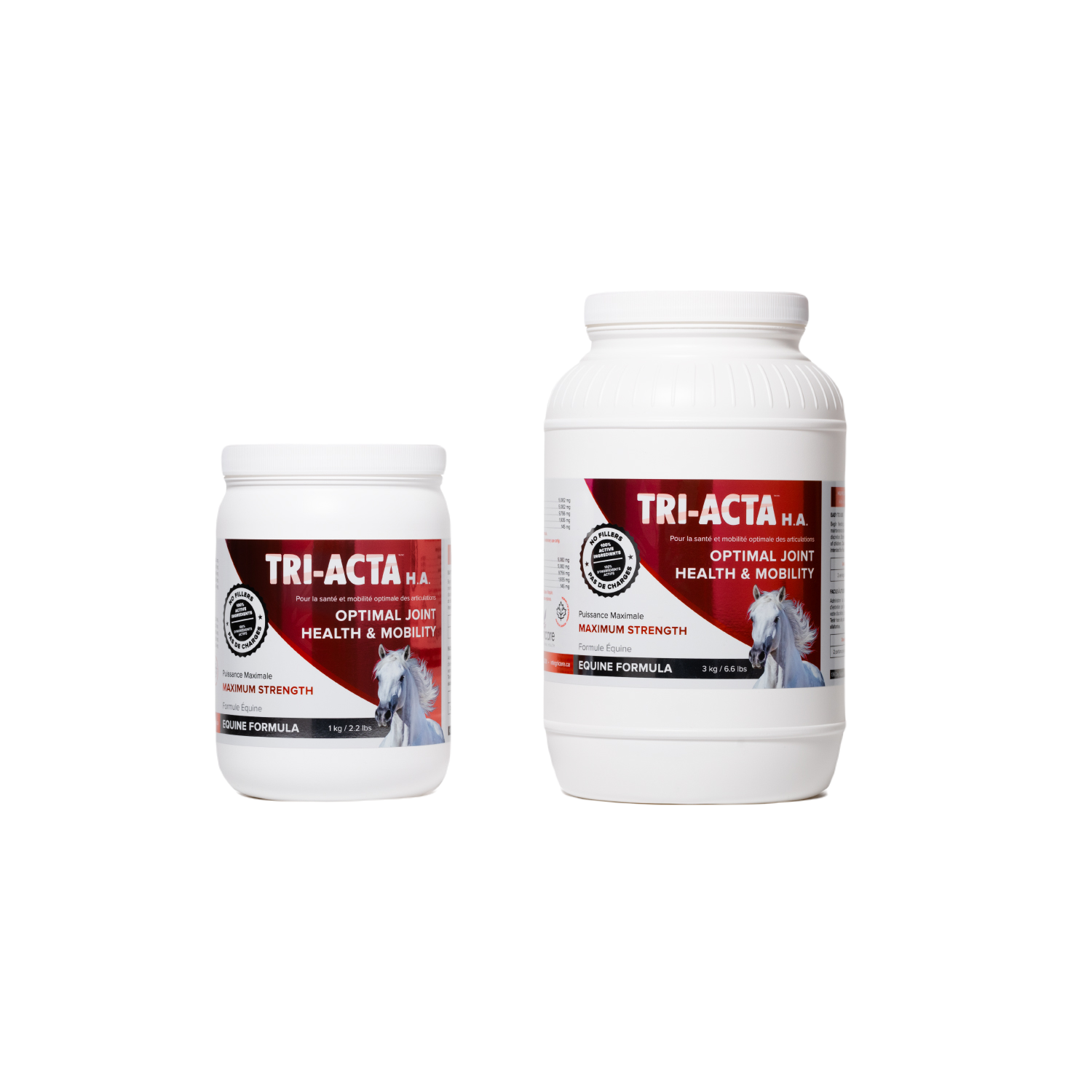
Treating Laminitis in Horses
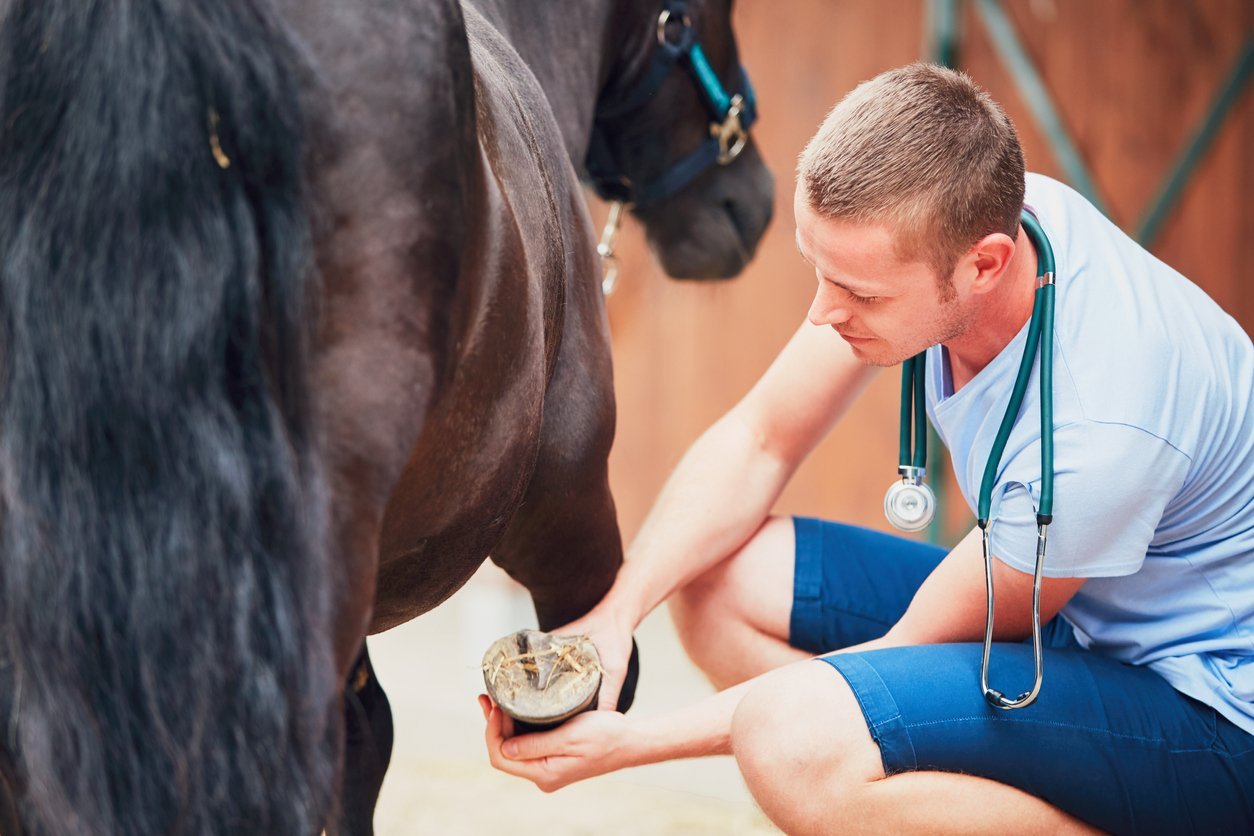
Laminitis in horses is a very serious condition, but thankfully it can be treated and managed in most cases. It’s imperative that you start treating your horse for laminitis immediately once you recognize the signs and symptoms of the disease, and have a vet confirm the diagnosis.
Your vet can advise you further on how to get started with treating laminitis in your horse, but there are a few preliminary steps you can take immediately:
- Remove any feeds, licks, or treats with high sugar content
- Immediately take steps to feed your horse a diet suitable for laminitis
- Move your horse to a paddock with less grass, and consider using a grazing muzzle if required
- Add horse supplements to your horse’s diet, such as TRI-ACTA H.A. for Equine, which is a good bet for horses currently suffering from laminitis, and for future prevention once recovered
- Pay careful attention to your horse’s feet — he may need remedial shoeing, foot balancing, or you may need to use pads or boots for comfort
Pain Relief for Horses with Laminitis
There are a few ways that pain relief can be provided to horses suffering from laminitis. The first course of action is to administer the appropriate drugs to treat various aspects of the disease, including inflammation, infection, and of course pain.
Antibiotics, anti-endotoxins, anticoagulants, painkillers (such as phenylbutazone), and vasodilators can be given to your horse to treat infections, provide pain relief, and reduce inflammation.
With laminitis, radiographs are necessary to determine the position of the pedal bone and see any changes within the hoof capsule. This paints a picture of the severity of the disease and helps vets determine a long-term prognosis. The radiograph information can also be used by the farrier to accurately trim the hoof and position shoes properly to provide the most optimal comfort and support for the horse.
In fact, good farriery is a key component in the treatment of laminitis, which makes sense as this skill is specific to maintaining the horse’s hooves. A horse’s foot must be carefully trimmed in an effort to correct the orientation of the pedal bone so it’s in a more angled parallel position to the bottom of the hoof rather than pointing straight downward.
When inflammation is under control, special heart bar shoes can be used to offer further support to the various bones in the hoof in an attempt to distribute the horse’s weight properly and prevent further pain.
Dietary Restrictions
Changing your horse’s diet is an essential part of treatment for laminitis. Removing high-sugar sources of food is a good first step, like limiting access to lush pasture through moving the horse to a dry pasture or using a grazing muzzle.
High-quality grass hay is the best forage to feed a laminitis horse, alongside feed that is balanced with essential nutrients and minerals essential for tissue repair and is low in starch. Horses should also have access to plenty of clean, tepid water to further support laminitis recovery.
Mineral Oil Treatment
Like all animals, horses can get into areas they are not supposed to be and eat things that they shouldn’t be eating. If grain binge, for instance, is suspected, there are a few ways that absorption of the substance can be limited.
But before any action is taken, it’s important to try and assess how much extra grain your horse has eaten. But even if it’s just a few extra pounds of grain, if the horse isn’t used to it, the extra addition to his diet can still cause adverse effects.
Absorption can be limited through the use of laxatives, mineral oil, extra fluids, and anti-inflammatories. Sometimes charcoal is often used via a nasogastric tube to limit absorption.
Laminitis in Horses Q&A
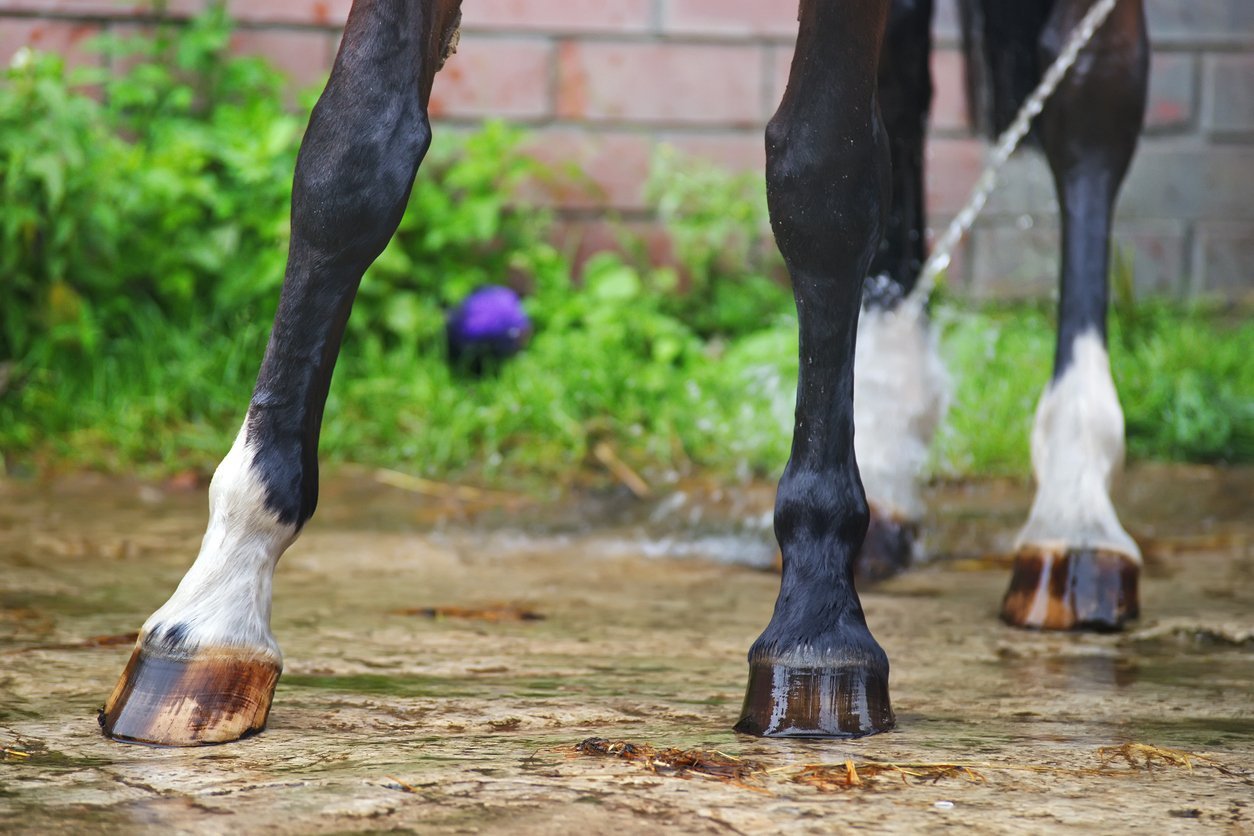
A serious disease like laminitis comes with a lot of uncertainty about whether your equine friend will live to see another year of carefree galloping in pastures and be able to live pain-free. Here are some commonly asked questions (and answers) about laminitis in horses.
What is the process for reversing laminitis in horses?
Reversing laminating in horses depends on a strict treatment regime focused on diet, as well as providing the horse with support and care through the use of antibiotics, anti-inflammatory drugs, and proper care of its hooves.
What is a new treatment for laminitis in horses?
After a decade of studying laminitis in horses, a research team in Australia determined that Velagliflozin, a newer veterinary drug, has been found to prevent laminitis in ponies with high levels of insulin. Clinical trials and testing for this new treatment for laminitis in horses are ongoing.
Can laminitis in horses be cured?
Oftentimes, laminitis in horses cannot be cured, which is why prevention, along with early detection and management of the disease is so important.
If careful attention is paid to diet, farriery, and the areas in which the horse is walking on, then the disease can be managed effectively. It’s also important to understand what originally caused the laminitis, and whether that cause has a solution or whether it has to do with the horse’s genetic makeup.
Is there a natural treatment for laminitis in horses?
Humans use natural medicines all the time for our own ailments, so it’s no surprise that natural solutions for laminitis in horses are available as treatment options for our equine friends. The science on some of these methods is loose or questionable (such as homeopathic options) but there is definitely some usefulness in balancing the right combination of vitamins, minerals, essential fatty acids, and more in keeping your horse comfortable.
However, a horse should be assessed by a veterinarian before the owner decides to turn to natural treatment options.
Summary
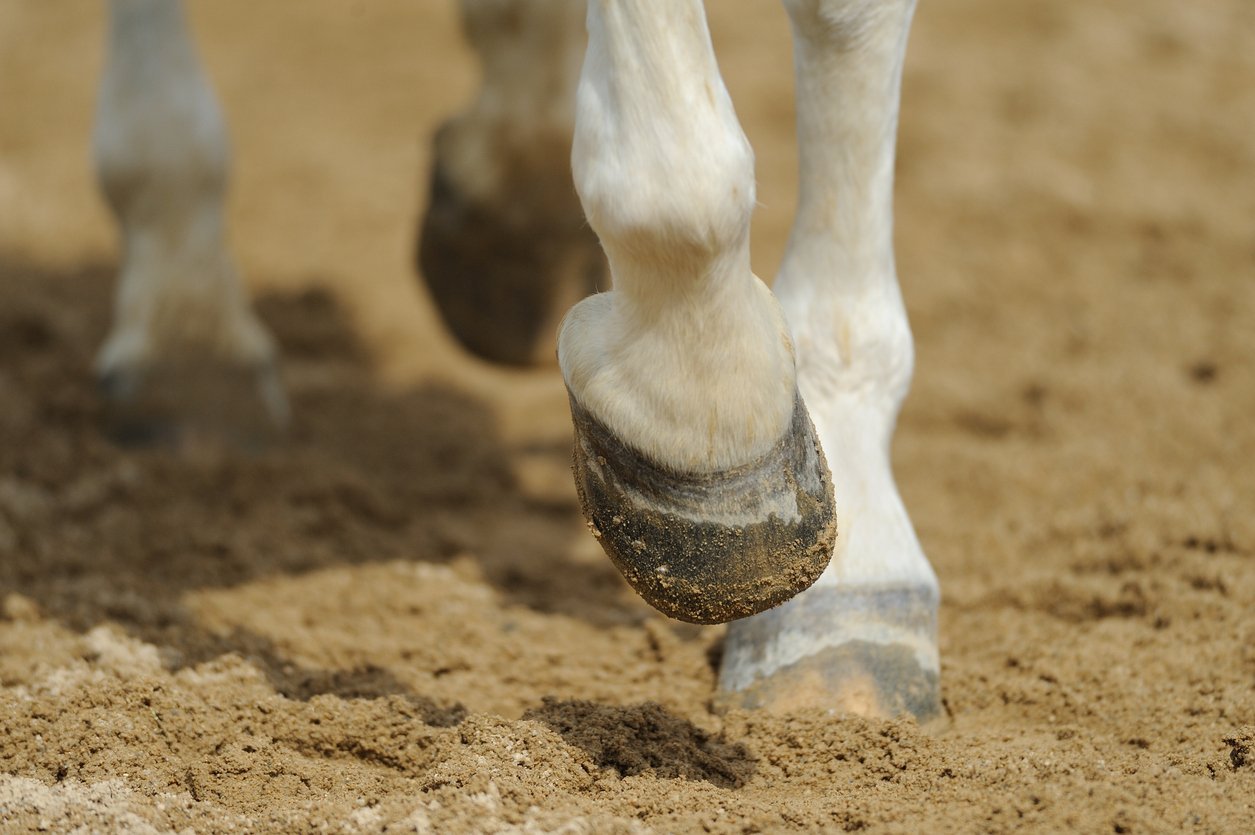
Although laminitis in horses is a common disease, it’s much more than a natural part of an ageing horse: it’s a chronic condition that can be onset by poor diet, a horse that has been worked too much, or as a secondary result from a genetic disease, Equine Metabolic Syndrome or Cushing’s disease.
Proper treatment of laminitis in horses is essential to keep your horse happy, healthy, and pain-free. Most treatment options for laminitis in horses have to do with diet control, pain management, and appropriate farriery care.
Any step that you can take to prevent your horse from developing laminitis will only prove to be beneficial in the long run. One of the ways you can start the prevention process is by incorporating supplements into your horse’s diet to ensure he is getting enough of the essential vitamins and minerals he needs to maintain good health.
TRI-ACTA for Equine is a great option for younger horses, while TRI-ACTA H.A. is a more robust option for older horses, competition horses, or horses that perform a lot of work. It includes hyaluronic acid, which has additional therapeutic effects that support your horse’s health.
Learn more about how you can support your horse’s health with our equine supplement products.
Newsletter Signup
Subscribe to our newsletter to receive the latest news and exclusive offers.
.jpg?height=2000&name=Cliick_Integricare-DISPLAY-REVISEDV2%20(1).jpg)
Proactive & Therapeutic Joint Supplements
When given daily, Integricare joint supplements recover bone and joint injuries faster and help prevent mobility injuries from happening in the first place.

